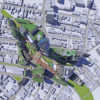NJCU’s West Campus development continues to grow as new buildings appear on the 21-acre site. The total projected estimate for the project, also known as University Place, is about $400 million, most of which is coming from real estate developers.
The first building constructed was the West Campus Village dorm in 2016. Since then, new luxury apartment buildings were built. However, there are questions about who will benefit from this project, how it’s being funded, and where the money will go.
To make University Place a reality, NJCU has entered into Public-Private Partnerships (P3) with several real-estate developers. Based on these partnerships, the buildings created will bring in revenue for the school– approximately $1.4 million annually. However, it will take time for the school to receive the full amount.
This University has given 50-year ground lease agreements to the real-estate developers. In some cases, developers received 30-year tax abatements from the city.
Back in 2017, NJCU President Sue Henderson called West Campus a “game changer” and said, “We are moving another step closer to revitalizing our city’s West Side and to providing NJCU students, faculty, and neighbors with a welcoming place to live, work, dine, and shop. Think of the enormous impact these buildings and future University Place projects will have on our community.”
By doing the P3’s, NJCU can expand beyond the dorm. The plan calls to create a new Music, Dance and Theatre building (MDT) as well as a Performance Arts Center (PAC) which will feature stages, dance rooms, three restaurants and more. Plans also call for 10 stories of luxury apartments on top of the PAC. Revenue from the ground leases will help finance the MDT and the PAC according to Vice President and Chief Operating Officer Aaron Aska.
Why P3’s
Creating income streams from non-academic sources like real estate development seems to be a trend with several New Jersey colleges due to shrinking state aid for public schools. Montclair University was the first New Jersey college to use a P3, forming a 40-year lease agreement with Provident Resources Group to build a dormitory worth $211 million through tax-exempt bonds. Montclair will own the dormitory once the bonds are paid or the 40-year lease agreement is over.
The state aid to NJCU has declined over the past 12 years. According to the New Jersey Association of State Colleges and Universities, in 2006, NJCU got $33.5 million. By 2019, that was down to $24.2 million. However, NJCU is not alone. The decrease in funding is a state-wide trend.
How Much and When
The first luxury building to open was Rivet I (Block 3). The apartment building has been open since 2019 and was developed by Claremont Construction Group Inc. It offers studios, one-and-two bedroom apartments, a courtyard with a grilling station, a game and lounge area, a movie screening room, fitness center, cafe, pet spa, Cuteicles Nail & Spa, Carvel ice cream parlor, and a Five Guys.. The average rental rate is about $2,000. According to a May 2019 presentation given at an NJCU town hall meeting, Rivet is expected to bring the university $209,000 annually.
However, the university will not receive money until 2022. In an email interview with Chief Operating Officer Aaron Aska, he said, “the $1.4 million “income will be earned between FY22 – FY26”.
As a follow-up, The Gothic Times asked Aaron Aska to explain why there is a delay in income given that some of the apartment buildings are already open. At press time, the Gothic Times did not receive a response.
In a phone interview with President Sue Henderson in early March, she said there is a delay in the money coming in based on the contract with the developers. Henderson said: “The way that it is written you give them a year to fill the apartments and if they don’t fill them, the developers will still have to pay. It’s standard policy.”
Associate Vice President, Marketing and Communications Sherrie Madia shared a statement through email on Henderson’s behalf with a background on University Place, (see statement after the end of the article).
Student Government Association (SGA) President Ricky Cruz said he doesn’t know why the university is not currently receiving money from Rivet I and CityLine West, which are already open. “I don’t know. I’m not familiar with that,” Cruz said. “The University has a commitment to grow and expand to build a community within Jersey City.”
At the same time that excavators, bulldozers, and cranes at NJCU are in action, enrollment is down, tuition is increasing and the university has a deficit. In February, Henderson released a letter saying NJCU needs to strengthen its financial reserves.
Huiyu “Peggy” Zhu, a student majoring in finance said the school’s focus on West Campus is not fair. “We don’t support the school for putting so much effort on this expensive project and our tuition increasing. Our parents work hard for us to attend here. It’s nice and all, but for so much money why increase our tuition?”
In contrast, Henderson said the university is among the states in New Jersey with low tuition. “Any tuition increase we do, we need to make sure we haven’t hurt the students who come from modest schools. The reason that schools end up increasing tuition is because they give up alot of discounting. They give institutional aid, scholarships, and more money from the federal government like tag or pell grants. 65 percent of our students are tag or pell students. We try not to hurt the students but you are getting more money from the federal government.”
Henderson also said that Vice President and Chief Financial Officer Jim White makes sure the university budget goes in the right direction. “We now know what we don’t need to be spending on. We already have reserves and are working on making it better.”
OTHER BUILDINGS ON WEST SIDE
West Campus Village was the first building to be built with help from a private corporation, RISE Development, NJCU and the foundation. In 2015, the university finalized the sale of $50 million in bonds for the dorm. Bonds were issued by the New Jersey Education Development Authority.
City Line West (Block 5B) is a luxury market rate apartment building that opened in October 2019 at University Place. It was developed by KKF University Enterprises, and features shuttle service to PATH trains, a cafe and lounging areas, rooftop for barbeque and lounging, a fitness center, yoga room, concierge, controlled access garage, pet washing station, and a storage for bicycles. The average rental rate for apartments begins at $2,000. City Line West is expected to eventually bring in $132,000 annually to NJCU.
The campus also has a new road, Gothic Knights Road, paid for by a donation of $16 million from the city of Jersey City for infrastructure such as streetlights and pavers.
Across Gothic Knights Road will be two additional market rate apartment buildings according to Aska.
“Rivet II (block 2) is in construction and the anticipated completion is in March, 2021,” Aska said. “City Line East (block 1) is in construction and the anticipated completion is in August, 2021.”
Rivet II will be developed by Claremont Construction Group and is expected to bring in $233,400 annually on February 1, 2022. City Line East will be developed by KKF University Enterprises and bring in $146,000 on April 21, 2025.
ShopRite supermarket (Block 6), will be developed by Crossroads Companies. The supermarket will bring an income of $650,000 to the University. Henderson said ShopRite is still in the process of being “finalized.”
NJCU has partnered with the Joffrey Ballet School to offer students to attend and earn a Bachelor of Fine Arts. Currently, there are more than 40 Joffrey Ballet students attending the school. Once the PAC and the MDT buildings are built, the students will take courses there as well. The Music, Dance, and Theatre building will feature classrooms, stages and dance rooms.
Aska said once financing is in place, construction for the PAC and MDT buildings will begin in the fall of 2020. Both buildings will be developed by Claremont Construction Group Inc.
Real Estate Developers
Strategic Development Group
Based in Fairfield, the Strategic Development Group (SDG) is a real estate developer specializing in projects that focus on underdeveloped assets and transforming neighborhoods. The Chairman and CEO of SDG is Anthony Bastardi, an engineer, and member of the board of the NJCU Foundation. Some recent SDG projects include two developments for NJCU and one for Saint Peter’s University. Bastardi is a consultant for NJCU and will “provide real estate advisory services,” Aska said.
In an email interview, Bastardi said. “My firm, Strategic Development Group, serves as special advisor to the university for real estate development, including all of University Place. In fact, our firm master-planned and branded University Place five years ago and directed all development projects there since then, including the current project that includes the Performing Arts Center and the Center for Music Dance and Theater.”
Does Bastardi see his work as a developer and foundation board member as a potential conflict of interest? Not necessarily. When asked if he was getting paid for his services to NJCU, he said, “You are getting into legal matters,” and recommended The Gothic Times speak with the university’s lawyer Al Ramey. Ramey did not respond to an interview request.
However at a February Board of Trustees meeting, Ramey was asked again for an interview request but refused the request and referred to speak with the university’s press office in which Madia responded with a statement, (see statement after the end of the article).
Henderson said that she does not think Bastardi is a potential conflict of interest. “Most institutions don’t have a staff member who knows how to do real estate. [Bastardi] does not discuss this matter with the university and he steps back.”
When asked if Bastardi was being paid for his services she said, “He’s been responsible for these deals. You get paid when the deal gets done. When we started doing some of the work with the City, some of the funds went to him. Some is our money and some is from deals and other deals.”
When The Gothic Times again asked how much Bastardi is being paid, Henderson said “That will be a personnel decision. That will be something I would have to check with Al [Ramey]. We generally don’t talk about personnel decisions.”
Henderson said that Bastardi has been a special advisor and a consultant for the university since the university began working on the West Campus in 2012.
Claremont Construction Group Inc.
Claremont Construction Group Inc. is part of the Claremont Companies, and has been in business since 1954. Located in Far Hills, N.J., it was originally a commercial painting business, but over time evolved into a full-service development and construction company. Claremont has completed many commercial, retail and residential projects. One well known project is The New Jersey Performing Arts Center in Newark. Their executive team consists of Donald and Stephen Sciarletta. Between the two Sciarletta brothers, they run ongoing projects and handle everything on an administrative end.
KKF University Enterprises
KKF University Enterprises is part of the PRC Group located in West Long Branch New Jersey. They are a residential and commercial real estate development, construction and property management firm. Previous projects include Campus Town at The College of New Jersey and student housing at The Peddie School in Hightstown. The CEO of the PRC Group is Robert M Kaye. His career began in 1960 and he is well recognized in the Tri-State area for his work over the years.
RISE Development
Since 2016, RISE Development has been located in Brooklyn, New York. According to their website, RISE is currently working on 15 projects in premiere markets spread between New Jersey, New York and Florida. Their team of workers has over 140 years of combined experience.
Tax Abatements
Tax abatements are reductions of property taxes for real estate projects. Claremont Construction Group Inc. and KKF University Enterprises received 30-year tax abatements for Rivet I and City Line West . The abatements were approved by the Jersey City City Council for the West Campus project.
Ward D Councilman Michael Yun was on the City Council in 2013 and the only member to vote against the 30-year tax abatements. Giving tax abatements to developers excuses them from contributing to the Affordable Housing Fund in Jersey City which gives money for community outreach, Yun said.
“They are not contributing to school tax, county tax,” Yun said. “When there’s some major project, those taxes are paid by the public, and the general homeowner, and increase regular homeowners’ taxes. That’s why I’m not happy with that tax abatement. A residential unit, they’ll have a lot of children in those units. Who will pick up the school tax? As I understand, almost $80 million will not go to schools because of tax abatements in Jersey City. That is a lot of dollars.
“The Affordable Housing Trust Fund, if they build a residential unit at market rate, they usually contribute so many dollars for each unit to go to the Affordable Housing Trust Fund,” Yun added. “But even though they contribute to the Affordable Housing Fund, those funds are not enough to build Affordable Housing units because they contribute a dollar amount that is far below the market amount. With less affordable housing there will be more gentrification.”
There are three hot issues in Jersey City: crime, parking, and housing- especially housing, Yun said. In a short period of time, Jersey City has developed a booming Jersey City.
“There is serious gentrification,” Yun said. “A lot of long-time people living in Jersey City had to pack up and move out. This is not fair. If they build luxury condos or apartments we have to make sure a certain number of the units are provided for long-time Jersey City residents to live there.”
Professor of Real Estate at NJCU Business School on the Jersey City waterfront, and former director of the Jersey City Redevelopment Agency Robert Antonicello has spent many years of his professional life working with developers in Jersey City. He says tax abatements are necessary to attract developers.
“A developer is not going to develop a piece of property where it’s going to lose money,” Antonicello said. “But for the tax abatement, the project wouldn’t go forward.”
Antonicello serves on the board of the NJCU Foundation, and said NJCU President Sue Henderson’s administration took a visionary step when it decided to make use of the 21-acre property the school purchased from Honeywell.
“Colleges are turning to real estate to bring in revenue,” Antonicello said. “Schools like Penn State, Drexel, La Salle and Temple, which are all urban schools, play a leading role in how their communities get developed. The West Campus is a natural extension of NJCU.
“Universities have to look elsewhere to begin to find money,” Antonicello added. “Clearly this has been a trend, and it’s been a good trend that’s provided options where options did not exist. They have land and now they can monetize the land.”
Additional reporting by Sally Deering, Nevin Perkins, and David Wilson.
NJCU’s University Place
A statement by Associate Vice President, Marketing and Communications Sherrie Madia
In 2012, the University was invited to submit proposals for new or upgraded buildings on campus as part of the Go Bonds (a $1.2 billion program for all public universities). NJCU submitted two proposals—one for the Science Building and one for the Arts. These were both growth areas for the University in terms of enrollment and community engagement. The state was focused on the sciences and provided NJCU with $32 million for a Science Building. The project cost was $42 million, so the University borrowed the remaining $10 million so that the project could be completed. Enrollment in that area has grown significantly along with the research agenda of the faculty. The University has the same number of faculty as we have had for the many years, despite lower enrollment. We have invested in faculty in growth areas.
To fund the Arts, the University determined to use a model adopted by Rowan University, The College of New Jersey, and Rutgers—a P3 or public private partnership project. The universities mentioned above had facilities built on their campuses that brought in revenues that helped pay for the debt on the building they needed for academic purposes. Like other institutions, NJCU lacked internal expertise in completing the real estate transactions, and hired a consultant to lead the process. The four market-rate housing projects are being built on a staggered plan to allow each owner the opportunity to fill their apartments before the next project opens. The rental costs are far below those on the waterfront. Rivet was the first project to open and is now full. Importantly, we are pleased to note that those who have rented at Rivet are largely residents of the Jersey City community. The second, City Line, is halfway full. These projects are owned and operated by a private company that pays NJCU a ground lease each year, according to the lease agreement. Each project was afforded a ramp-up year before they paid their initial ground lease.
The University Place projects allow NJCU to create much-needed educational space and classrooms for the Music, Dance and Theatre program without having to pay for the building. The ground leases, along with the rent paid by Joffrey Ballet School each year and the new Joffrey students are effectively covering the cost of the building through the
payments of the mortgage. This model was used by other New Jersey universities and is common throughout the country.
As a general matter, members of the NJCU Foundation Board are not automatically prohibited from serving as consultants with the University. With regard to the NJCU Foundation, it is standard practice for Directors to recuse themselves from any voting matters deemed perceived or potential conflicts of interest.
The campus has dedicated significant internal capital money for repairing its infrastructure. NJCU continues to work to upgrade Grossnickle and to complete infrastructure work for heating and cooling throughout the main campus facilities using its yearly capital monies. We will complete additional facilities work on the Margaret Williams Theatre this summer. These efforts will help to enhance our facilities in the short term. The University is also investigating another P3 initiative that would feature a new cogeneration plant, much like the one built by Montclair State, which would be a good long-term solution. If and when the Energy P3 bill is passed, the University would be able to explore this more cost-effective means of energy production.
At a time when State investment in new facilities for higher education is not keeping pace with the facilities needs across colleges and universities, institutions are responding with innovation by identifying alternative ways to build additional academic facilities. Essentially, the projects on NJCU’s University Place properties represent a use of the University’s long-term investment in acquired real estate to generate a revenue stream that provides financial resources for support of the institution without shifting that cost to the students.











